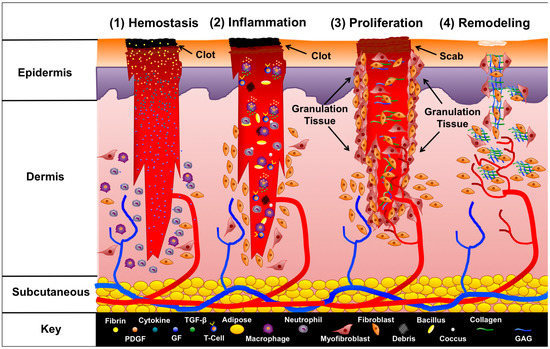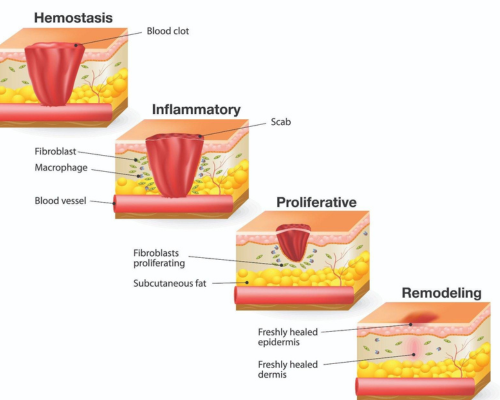
Hyaluronic acid (HA) and hyaluronan are now widely used in pharmaceuticals, cosmetics, and food industries. Hyaluronic acid has many proven benefits. In the medical field, HA has shown excellent efficacy in treating rheumatoid arthritis, preventing post-surgical adhesions, and targeting tumor therapy. This article will introduce another medical application of HA: promoting wound healing.
Physical and Chemical Properties of HA
HA is a large molecular chain polysaccharide composed of glucuronic acid and N-acetylglucosamine (molecular weight > 106 kDa). It is widely present in the extracellular matrix of animals, particularly abundant in the dermis and epidermis.
The concentration and molecular weight of HA vary across different tissues. The skin, umbilical cord, and joint synovial fluid have higher HA concentrations and molecular weights compared to plasma.
HA from different sources has the same structure, with no species-specific differences, only varying in molecular weight. Different extraction and purification processes also cause significant differences in HA’s molecular weight.
Natural HA has certain tissue-filling and anti-adhesion functions. However, due to its rapid degradation and short residence time in the body, its effect is limited. Exogenous HA is modified after synthesis.
This modification can be through cross-linking or adding chemical groups. Cross-linking can increase its molecular weight and make it not easily degraded. Adding chemical groups can change HA’s physical and chemical properties, making it a carrier or binding it with drugs.
The Role of Medical Grade Hyaluronic Acid in Wound Healing
Wound Healing Process:

Exogenous high-concentration, high-molecular-weight HA has anti-inflammatory effects, regulates collagen synthesis, and promotes wound healing. The specific mechanisms are elaborated below:
1. Structural Function of HA in Wound Healing
Medical-grade hyaluronic Acid, combined with fibrin, forms a clot that is structurally in wound healing. Wound healing involves the reconstruction of the extracellular matrix. During tissue generation and wound healing, a large amount of HA is produced locally, marking the beginning of matrix synthesis.
Early HA appearing locally at the wound interacts with various HABPs such as CD44 and RHAMM on cell membranes. This interaction induces the aggregation of macrophages and lymphocytes in the damaged area. Subsequently, cytokines like transforming growth factor (TGF-β) are released, promoting fibroblasts to synthesize HA, collagen, and glycosaminoglycans.
In the following second and third stages, the loose matrix composed of HA and fibrin is gradually degraded by HAase and reactive oxygen species released by neutrophils. The degradation products, LMWHA and o-HA, promote capillary formation and collagen synthesis, with the loose matrix replaced by a dense matrix primarily composed of collagen and sulfated glycosaminoglycans.[i] Both exogenous and endogenous HA can participate in the formation of the extracellular matrix, with their degradation products being LMWHA and o-HA.
2. HA regulates inflammatory responses
In the second stage of wound healing, the inflammatory phase, HA’s anti-inflammatory effects are evident:
- Exogenous, high-viscoelastic HA inhibits the adhesion and phagocytosis of macrophages, monocytes, and granulocytes. This effect is related to its physical properties of viscoelasticity. High-viscoelastic HA forms a barrier on the cell surface, preventing cell-cell interactions.
- HA activates peripheral blood mononuclear cells, inducing the expression of growth factors and exerting anti-inflammatory effects.
3. HA Promotes Epithelial Cell Proliferation and Angiogenesis
Angiogenesis during wound healing partially overlaps with the inflammatory phase. Studies have shown that the molecular weight of HA affects its role in angiogenesis:
- High molecular weight HA inhibits angiogenesis, while low molecular weight LMWHA and o-HA promote angiogenesis.
- High molecular weight HA inhibits endothelial cell proliferation, while low molecular weight HA activates endothelial cells and promotes their proliferation.
- High molecular weight HA inhibits the migration of endothelial cells into gaps, while low molecular weight HA increases collagen synthesis.
4. HA Promotes Fibroblast Proliferation and Regulating Collagen Synthesis
Fibroblast proliferation occurs in the final stage of wound repair. Experiments by Rooney [ii]found that o-HA with a relative molecular weight of 1200-4000 can promote fibroblast proliferation and collagen formation.
5. HA retains moisture
The hydration state of tissues is crucial for cell survival. In dry wounds, epithelialization slows down or even stops. Maintaining tissue hydration can double the speed of epithelialization.
Research on the wound healing benefits of hyaluronic acid
Recent research on hyaluronic acid (HA) in wound healing highlights its multifunctional role and the development of innovative HA-based treatments. Here are some of the latest findings:
Antibacterial Properties: A study published in Biomaterials Research introduces a novel antibacterial HA dressing combined with ε-polylysine (HA-EPL). This dressing not only promotes healing in infected wounds but also features on-demand removability, which is crucial for minimizing damage during dressing changes.[iii]
Composite Hydrogels: Another study in Academic OUP reports on the development of a composite hydrogel made from polyvinyl alcohol (PVA), tannic acid, silicate, and HA. This hydrogel addresses chronic wounds, particularly in diabetic patients, by providing a multifunctional platform that combats severe inflammation, bacterial infection, and poor vascularization.[iv]
Wound Dressings and Moisture Retention: A review in MDPI highlights the broad use of HA in various medical fields, emphasizing its ability to maintain a moist environment that promotes healing. HA’s hydrophilic properties help retain moisture in wound dressings, accelerating the healing process by providing optimal conditions for cell migration and growth factor stimulation.[v]
These studies underscore the versatility and effectiveness of HA in wound care, suggesting that ongoing research and innovation in HA-based treatments will continue to improve outcomes for patients with various types of wounds.
Conclusion
Hyaluronic acid plays a multifaceted role in wound healing, from regulating inflammation and promoting cell proliferation to enhancing collagen synthesis and maintaining tissue hydration. Its diverse medical applications make it a valuable tool for improving wound healing outcomes. With ongoing research, the therapeutic potential of HA continues to expand, promising new advancements in medical treatments.
[i] Weigel PH,Fuller GM,Le Boeuf RD.A model for the role of hyaluronic acid and fibrin in the early events during the inflammatory response and wound healing[J].J Theor Biol,1986,119(2):219-234.
[ii] Rooney P,Wang M,Kumar P,et al.Angiogenic oligosaccharides of hyaluronan enhance the production of collagens by endothelial cells[J].J Cell Sci,1993,105(Pt1):213-218.
[iii] Hu, D., Wen, J., Zhao, X. et al. A wound-friendly antibacterial hyaluronic acid dressing with on-demand removability for infected wound healing. Biomater Res 27, 38 (2023). https://doi.org/10.1186/s40824-023-00340-7
[iv] Zhentian Diao, Longkang Li, Huan Zhou, Lei Yang, Tannic acid and silicate-functionalized polyvinyl alcohol–hyaluronic acid hydrogel for infected diabetic wound healing, Regenerative Biomaterials, Volume 11, 2024, rbae053, https://doi.org/10.1093/rb/rbae053
[v] Antoszewska, M., & Sokolewicz, E. M. (2024). Wide Use of Hyaluronic Acid in the Process of Wound Healing—A Rapid Review. Scientia Pharmaceutica, 92(2), 23. https://doi.org/10.3390/scipharm92020023
